 Back to Silver
Drawing Tests
Back to Silver
Drawing TestsScoring the Silver
Drawing Tests
Scoring
Copyright 1983/1990/1996 by Rawley Silver, reprinted with permission
from its original publication.
No portion of this work may be copied without written consent by Rawley Silver.
The following are excerpts from
Silver, R. A. (1996). Silver Drawing Test of cognition and emotion. Sarasota, FL: Ablin Press.
Scoring the SDT's
Scoring time is usually three to six minutes for each test booklet. Record sheets for entering individual and group scores are provided in Appendix A (pages 127 and 128). To compare individual scores with average scores and percentile ranks, see the normative data in Appendix B (pages 129-134).
The scorer is cautioned about combining subtest scores into total scores. Some examinees receive low scores in some cognitive abilities, high scores in others. Consequently, their total scores can mask particular strengths and weaknesses.
The scorer is also cautioned about the self-report requested in response to the Drawing from Imagination task (page 126). We have found that the self-reports are often unreliable and suggest resistance to disclosure. Nevertheless, they provide insight into masked depression, denial, and unconscious feelings, and can be useful when talking with respondents about their drawings.
page 24
Copyright 1996 Rawley Silver
FIGURE 14. Predictive Drawing by George, age 13, Expressive and Receptive Language Impairments.
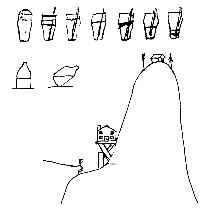
page 39
Copyright 1996 Rawley Silver
FIGURE 15. Predictive Drawing by Caroline, Age 3 years, 8 months.
Predicting a Sequence I
Predicting Horizontality 2
Predicting Verticality 0

Suppose you tilted a bottle half filled with water.
![]()
Draw lines in the bottles to show how the water would look.
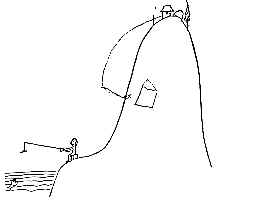
Suppose you put the house on the slope at the Spot marked X. Draw the way it would look.
page 40
Copyright 1996 Rawley Silver
FIGURE 16. Drawing from Observation
Horizontal relationships: 4 points. (All four objects are approximately correct in left-right order but not carefully observed and represented).
Vertical relationships: 4 points. (All four objects are approximately correct in height but not carefully observed and represented).
Relationships in depth: I point. (One object is above the base line).

page 41
Copyright 1996 Rawley Silver
Horizontal relationships: 5 points.(The horizontal relationships are accurate).
Vertical relationships: 5 points (The vertical relationships are accurate).
Relationships in depth: 5 points (The relationships in depth are accurate and the layout sheet is included in the drawing).
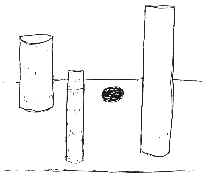
page 41
Copyright 1996 Rawley Silver
FIGURE 23. Drawing from Imagination by Roy, age 17. Title: The Great House Murder
Ability to Select 5 points. Imaginative, well-organized, implies more than is visible.
Ability to Combine 5 points. Overall coordination, takes into account the whole area.
Ability to Represent 5 points. Highly expressive, playful.
Cognitive Total: 15 points
Projection Scale 1 point. Solitary subject in mortal danger. Aggressive humor.
Self-Image Scale 5 points. Roy seems to identify with the narrator or the invisible murderer.
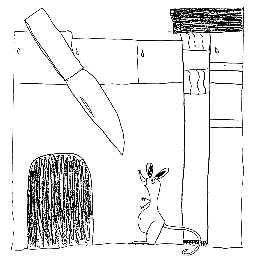
figure 23 page 49.
Copyright 1996 Rawley Silver
FIGURE 20. Drawing from Imagination by Dan, age 15. Expressive Language Impairment, Normal Hearing. No title.
Ability to Select 3 points. Dan seems to have selected his subjects at the functional level watching TV, boy riding bicycle, girl roller-skating.
Ability to Combine 2 points. Although his drawing is fragmentary, a vertical line separates inside from outside with a door at the base.
Ability to Represent 2-points. Dan restructured the stimulus drawing girl, boy, and tv and added the sidewalk, bicycle, etc.
Subtest Total 8 points. Below average, at the 28th percentile.
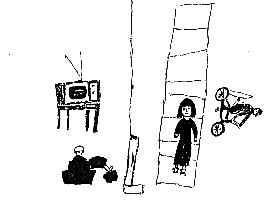
figure 20 page 46.
Copyright 1996 Rawley Silver
![]() Continue to Relationships
Between the SDT and Traditional Tests
Continue to Relationships
Between the SDT and Traditional Tests